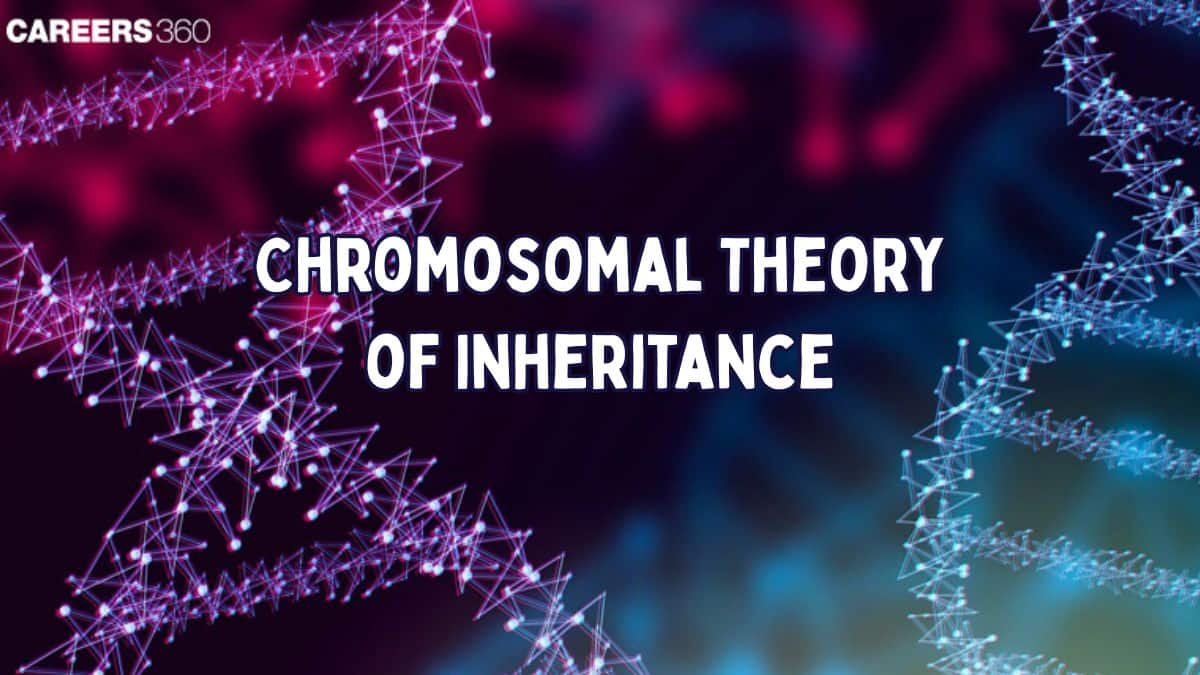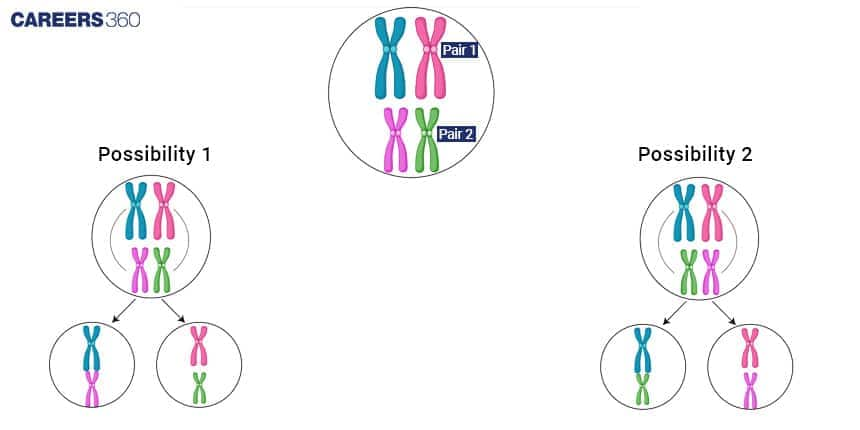Chromosomal Theory of Inheritance: Observations and Inheritance
The Chromosomal Theory of Inheritance explains how traits are passed from one generation to the next through chromosomes. The Chromosomal Theory of Inheritance was proposed by Walter Sutton and Theodor Boveri independently in 1902–1903. It highlights how genes are located on chromosomes. It determines characteristics such as eye color, height, and even inherited diseases in biology.
This Story also Contains
- What are Chromosomes?
- Chromosomal Theory of Inheritance
- Diagram Showing Chromosomal Theory of Inheritance
- Linkage and Genetic Recombination
- Chromosomal Theory of Inheritance Observations
- Chromosomal Abnormalities
- MCQs on the Chromosomal Theory of Inheritance

The Chromosomal Theory of Inheritance successfully explained how Mendel’s factors (now genes) are carried on chromosomes. It provided a basis for Mendelian Genetics. The theory was proved by direct experimental evidence. Thomas Hunt Morgan experimented on the fruit fly (Drosophila melanogaster) and proved the theory as a biological principle. The Chromosomal Theory of Inheritance supports the Principles of Inheritance and Variation through chromosome behavior.
What are Chromosomes?
Chromosomes are thread-like structures found in the nucleus of a cell that carry genetic information in the form of DNA. They carry genes of traits that determine an organism's growth. Such chromosomes occur in pairs, one from each parent. It functions as a main channel for the passing of traits from generation to generation. In humans, there are 23 pairs of chromosomes and their function is to carry genetic information, control body traits, and sex determination.
Chromosomal Theory of Inheritance
The Chromosomal Theory of Inheritance carries genes on chromosomes and passes information from generation to generation. It provided a physical basis for Mendel’s three laws of inheritance. It connects the movement of chromosomes during meiosis to Mendel’s principle of segregation and independent assortment. The main features and explanations of Chromosomal Theory of Inheritance given below:
Chromosome Pairs: Chromosomes occur in pairs, one from each parent. During stages of meiosis, each pair splits, so each gamete gets one chromosome from each pair.
Genetic Diversity: Meiosis helps in variation by making sure that gametes are different. This is critical in producing genetic diversity.
Meiosis and Haploid Cells: Meiosis reduces the chromosome number to half, resulting in haploid cells. This is necessary so that when fertilisation takes place, the zygote will have the correct diploid number of chromosomes.
Separation of alleles: When gametes are being produced, alleles for each gene separate. This means that only one allele for a gene enters each gamete. This occurs when homologous chromosomes separate during Anaphase of meiosis I.
Independent Assortment: This follows Mendel’s law of independent assortment where different genes for different traits assort independently of each other. It occurs even when they are located on different chromosomes or different parts of the same chromosome. This happens because chromosomes align randomly during Metaphase I of meiosis.
Diagram Showing Chromosomal Theory of Inheritance
Given below is the diagrammatic representation of the chromosomal theory of inheritance. It shows how homologous chromosome pairs separate during meiosis, which leads to different combinations in gametes. At the top, there are two pairs of homologous chromosomes:
Pair 1: Blue and Pink chromosomes
Pair 2: Purple and Green chromosomes
Possibility 1:
Both blue and purple chromosomes go together into one gamete.
Both pink and green chromosomes go into the other gamete.
Possibility 2:
The blue chromosome pairs with the green in one gamete.
Pink pairs with purple in the other.

Linkage and Genetic Recombination
The Chromosomal Theory of Inheritance not only explains the inheritance of traits but also explains linkage and recombination. These processes occur during meiosis and are important for creating genetic diversity in offspring. Genetic diversity allows species to adapt and evolve. It makes sure that the offspring's traits differ from that of the parents.
Genes that are near each other on the same chromosome tend to be inherited together. Such inheritance is said to be in linkage.
During meiosis, there might be an exchange of parts between a pair of homologous chromosomes. This phenomenon is known as crossing over.
During recombination, it breaks the linkage between closely associated genes and produces new combinations of genes. Thus, an increase in genetic variation is ensured through recombination.
Sex linkage involves genes on sex chromosomes that show linkage and may undergo recombination, affecting trait inheritance.
Chromosomal Theory of Inheritance Observations
The Chromosomal Theory of Inheritance explains how traits are passed from parents to offspring through chromosomes. Simple observations during meiosis showed that chromosomes carry genes, follow Mendel’s laws of inheritance, and help in the inheritance of traits. This theory also explains how determination of sex is done and how certain traits are linked to sex chromosomes.
In diploid cells, chromosomes occur in pairs, one chromosome of each pair is inherited from each parent.
While making gametes (meiosis), the chromosome pairs segregate. Thus, this corresponds to Mendel’s law of segregation.
Non-homologous chromosomes are oriented by meiosis independently of one another and correspond to Mendel's law of independent assortment.
Genes occur on chromosomes, specific loci on specific chromosomes.
Meiosis leads to a reduction in the number of chromosomes in gametes so that at the time of fertilisation, the diploid state is regained.
The behaviour of chromosomes during meiosis directly relates to the patterns identified by Mendel concerning the inheritance of traits.
Specialized chromosomes such as sex determination in humans X and Y determine sex too, thus establishing that chromosomes carry genetic information.
Experiments carried out on Drosophila melanogaster, known as the fruit fly, showed that some characteristics were linked to specific chromosomes, such as eye colour being linked with the X chromosome. Inheritance was therefore directly linked to the action of chromosomes.
Chromosomal Abnormalities
Chromosomal abnormalities occur when there is a change in the number or structure of chromosomes. These abnormalities can lead to various human genetic disorders. They are mainly classified into numerical and structural abnormalities, both affecting normal growth and development. The main types of chromosomal mutations are:
Numerical abnormalities: These are generally the abnormalities in the number of chromosomes. Some of the examples include Down syndrome, also known as trisomy 21, which is caused due to an extra chromosome number 21. The other one is Turner syndrome, wherein females have only one X chromosome.
Structural Abnormalities: These involve changes in the structure of chromosomes. Examples include:
Translocation: Chromosome segments are shuffled between chromosomes.
Deletion: A segment of the chromosome is lost.
Duplication: A segment is copied, leading to extra genetic material.
Inversion: A chromosome segment is reversed within the same chromosome.
Video Recommended on The Chromosomal Theory of Inheritance
MCQs on the Chromosomal Theory of Inheritance
Question: The behavior of chromosomes was parallel to the behavior of genes observed by
George Gamow
Walter and Theodor
Nirenberg
Morgan
Answer: Walter Sutton and Theodor Boveri independently proposed that the behavior of chromosomes during cell division parallels the behavior of genes, a concept that laid the foundation for the chromosomal theory of inheritance. They observed that chromosomes segregate and assort independently during meiosis, just as Mendel's laws of inheritance describe the transmission of genetic traits. By linking the movement of chromosomes to Mendel's laws, they provided a physical basis for the inheritance of genes, demonstrating that genes are located on chromosomes and that their behavior during cell division helps explain the inheritance patterns Mendel observed.
Hence, the correct answer is option 2) Walter and Theodor.
Question: Select the correct statement from the ones given below concerning the dihybrid cross.
Tightly linked genes on the same chromosome show higher recombination.
Genes far apart on the same chromosome show very few recombinations.
Genes loosely linked on the same chromosome show similar
Tightly linked genes on the same chromosome show very few recombinations.
Answer: Genes that are closely related to one another on the same chromosome are likely to be inherited together. Recombination is the transfer of genetic material between chromosomes during meiosis and is therefore unlikely to occur between them. Because of this, the characteristics governed by these genes are frequently inherited jointly, resulting in fewer recombinations in progeny.
Hence, the correct answer is option 4) Tightly linked genes on the same chromosome show very few recombinations.
Question: What was the organism that T.H. Morgan used in his experiments on inheritance?
Pea plant
Fruit fly
Mouse
Bacteria
Answer: The organism that T.H. Morgan used in his experiments on inheritance was the fruit fly (Drosophila melanogaster).
Morgan chose this organism for his experiments because it has a short lifespan, produces a large number of offspring, and has a relatively simple genome. These characteristics made it easy to observe and analyze genetic traits in fruit flies. Morgan's experiments with fruit flies led to many important discoveries, including the identification of sex-linked traits and the mapping of genes on chromosomes.
His work laid the foundation for our understanding of the Chromosomal Theory of Inheritance, which states that genes are located on chromosomes and are transmitted through the process of meiosis.
Hence, the correct answer is option 2) Fruit fly.
Also Read:
Frequently Asked Questions (FAQs)
Chromosomal abnormalities give rise to genetic diseases, development aberrations, and health disorders of different types which would need occasional medical treatment and genetic counselling.